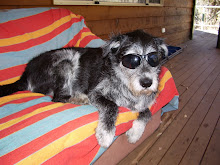 What a great place to have lunch!
What a great place to have lunch! The train ride from Sydney to Orange is wonderful.
The train ride from Sydney to Orange is wonderful.First you go through the city with its colourful graffiti and spectacular Jacarandas in bloom.
Then you climb up into the Blue Mountains where the views are spectacular.

Below is Orange; a large town in the Central Tablelands District of New South Wales. Orange is nine hundred feet above sea level. Originally known as Blackman's Swamp 'Orange' was so named by Surveyor-General Thomas Mitchell in honour of the Prince of Orange, who later became the King of Holland.
 November and the next morning we woke to snow! Two days later it was warm and sunny.
November and the next morning we woke to snow! Two days later it was warm and sunny.

I don't think I have ever seen so many lovely gardens in one town. No one seem to have any problem creating a colourful and healthy garden but this may be due to the soil. Twelve kilometres west of Orange is Mount Canobolas and millions of years ago this was a volcano; hence the good soil for hundreds of miles around Orange.
I haven't seen holly growing in Australia before!

 Orange has a couple of dams for its water supply but is on strict water restrictions.
Orange has a couple of dams for its water supply but is on strict water restrictions. We went up to the top of Mount Canobolas and found some remains of the snow that had fallen two days previously. Not enough to make a snowman, unfortunately.
We went up to the top of Mount Canobolas and found some remains of the snow that had fallen two days previously. Not enough to make a snowman, unfortunately. This is the picnic table at the top of the Mount and it was covered in lichen. I've only seen lichen growing in a temperature rainforest.
This is the picnic table at the top of the Mount and it was covered in lichen. I've only seen lichen growing in a temperature rainforest. We went for an hour's bush walk and would have gone further except it was getting dark.

 We spent a day in Canowindra (said: Canoundra) which is about 25mins drive from Orange. Back in the mid-fifties a chance discovery during road building revealed an extensive fossil bed dating back 360million years ago.
We spent a day in Canowindra (said: Canoundra) which is about 25mins drive from Orange. Back in the mid-fifties a chance discovery during road building revealed an extensive fossil bed dating back 360million years ago.

 We spent a day in Canowindra (said: Canoundra) which is about 25mins drive from Orange. Back in the mid-fifties a chance discovery during road building revealed an extensive fossil bed dating back 360million years ago.
We spent a day in Canowindra (said: Canoundra) which is about 25mins drive from Orange. Back in the mid-fifties a chance discovery during road building revealed an extensive fossil bed dating back 360million years ago. "From 12th to 22 July 1993 the original Canowindra fish site was excavated using the same Caboone Council excavator and driver. The project received full support of the Canowindra community - business people, farmers, truck drivers, teachers, students and local residents etc.
Results exceeded expectations! Some 70 tonnes of fossil slabs were recovered, some weighing more than 2 tonnes. The slabs, now stored in Canowindra on 100 pallets, contain over 3000 fish specimens. Almost all are complete and represent at least 6 specimens, some new to science."
Results exceeded expectations! Some 70 tonnes of fossil slabs were recovered, some weighing more than 2 tonnes. The slabs, now stored in Canowindra on 100 pallets, contain over 3000 fish specimens. Almost all are complete and represent at least 6 specimens, some new to science."
"The recovery of these remarkable fossils is only part of the link of in a unique chain of events which began 360 million years ago when a large lake or river, with tens of thousands of fish living in it, dried up during a severe drought.
The fish tightly concentrated in a small area were rapidly but gently covered with sediment soon after death and before their bony scales and plates fell apart.
Buried deep underground, the sediment turned to rock until some 360 million years later, this unique record of mass-mortality event was brought to the surface again by natural erosion. This happened where a country road intersected the fossil layer, it was pushed aside by the bulldozer driver and then its significance recognised and reported by a sharp eyed apiarist.
One wonders how many other such finds are never seen or reported and are lost to science!"
The fish tightly concentrated in a small area were rapidly but gently covered with sediment soon after death and before their bony scales and plates fell apart.
Buried deep underground, the sediment turned to rock until some 360 million years later, this unique record of mass-mortality event was brought to the surface again by natural erosion. This happened where a country road intersected the fossil layer, it was pushed aside by the bulldozer driver and then its significance recognised and reported by a sharp eyed apiarist.
One wonders how many other such finds are never seen or reported and are lost to science!"
We visited the "Age of Fishes" museum to see these wonderful plates.
Orange has some lovely parks, one of which was "Cook Park" dating back to the 1880's. They planted Sequoias and Oak which now tower above the park.
Orange has some lovely parks, one of which was "Cook Park" dating back to the 1880's. They planted Sequoias and Oak which now tower above the park.





No comments:
Post a Comment